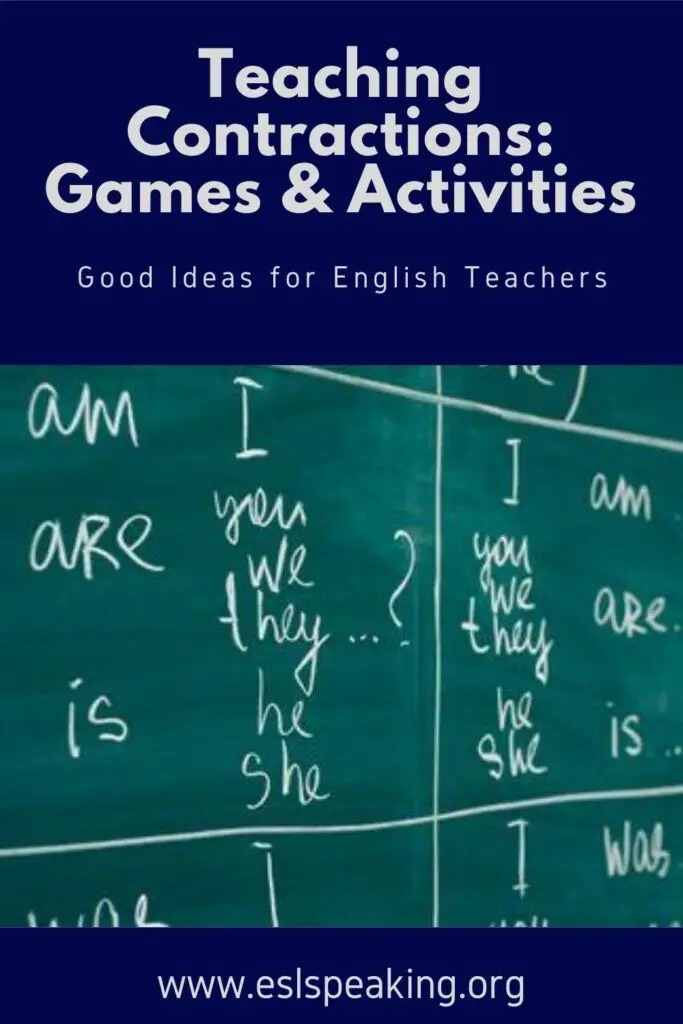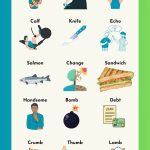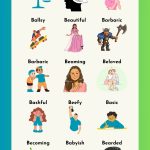If you’re looking for some of the best activities and games for a contractions lesson, then you’re certainly in the right place. We have our favourite options, along with online practice recommendations, lesson plans, worksheets and more. Keep on reading for all the details you need to know about teaching contractions.

ESL contractions activities and games
ESL Contractions Games and Activities
Let’s get into the best contraction ESL activities to try out with your students today.
#1: Got to Hand it to You
I love this game because it takes someone old (error correction) and makes it new again. It’s a fun way for students to get familiar with forms and meanings of contractions, including punctuation. Check it out here:
www.eslspeaking.org/esl-review-activity
#2: Running Dictation and Contractions
A nice way to focus on speaking with contractions and also with the correct writing of them is running dictation. It’s a 4-skills activity that works well for just about any topic, vocabulary set or grammatical point, including this one.
Find (or write) a conversation between two people who use lots of these kinds of words. Students have to work together to dictate it and when they’re done that, put the conversation into the correct order. If the goal is to work on contractions, I make a point to tell my students that I’ll be checking these specifically at the end of the activity so as to pay close attention. Find out all about it here:
www.eslspeaking.org/esl-game-running-dictation
#3: Relay Race Game
#4: Chain Spelling with Contractions
A fun game to help students with the spelling of contractions is this chain spelling one. Have all students stand up and then say the long-form or a word (cannot) or words (she is) that can form one. Students have to spell out the shorter form letter by letter, using the word “apostrophe” (write it on the board) for where that punctuation mark is. If someone misses, they sit down and are out of that round. The winner is the last person standing.
www.eslspeaking.org/chain-spelling-activity
#5: ESL Pronunciation Practice
A big part of English pronunciation is elision, which is learning how words are linked together when speaking in order to sound more fluent. Contractions are a key component of this. Say the following two sentences out loud to yourself:
- He’s going to school.
- He is going to school.
When writing, it doesn’t really matter which form you’d use. However, when speaking, the second sentence just sounds awkward and a native English speaker would never say this without a contraction. That’s why it’s key to include elision when teaching pronunciation to our students. Have a look here at some of the top recommendations:
www.eslspeaking.org/esl-pronunciation-games

Contractions ESL games and activities
#6: Contractions Vocabulary Auction
This is a fun vocabulary activity that does require a bit of preparation time. However, I find that it’s worth it if I’m going to be using it for a number of different classes. In this case, use contractions for all of the sentences that you make and students will have to decipher them to see if they fit with the other words that they bid on, or traded for.
Try out this fun activity with your students today! It’s the most fun you’ll have practicing this important skill all year.
www.eslspeaking.org/vocabulary-auction-esl-game
#7: Contractions Songs and Chants
When I teach kids, I love to include some songs and chants in my classes. I’m not musical, so YouTube is my go-to resource. There is a song or chant for just about any topic, including contractions.
#8: Contractions Puzzle Finder Game
I often use this puzzle finder game as a kind of icebreaker activity. However, it can also work well as a first introduction to this concept. Use two puzzle pieces that fit together and on one piece is the long form of the word(s) and then the other one has the shorter form of it.
Students have to mingle with each other to find their matches by only speaking. Once they think they found a match, they can try and see if the puzzle pieces fit together. Have a look here:
www.eslspeaking.org/puzzle-finder-esl-ice-breaker
#9: Listening Practice and Contractions
A nice way to introduce these words to students is to have them listen to some examples first. First, explain what contractions are and give some examples (if students don’t already know this). Then, play a passage with people using lots of these kinds of words and have students take notes about which ones they hear.
This can be a nice lead-in to an exercise where students have to listen for details and answer specific questions. Or, as a lead-in to a speaking lesson focused on contractions. It’s very flexible and the sky is the limit! Here are a few things to consider when planning a listening lesson:
www.eslspeaking.org/how-to-teach-listening-to-esl-students
#10: Telephone English Speaking and Listening Game
I’m sure you’ve played this game when you were a kid. The first person in line gets a secret message that gets passed down the line until the last person. Then, their message is compared to the what the first person heard. The results? Usually hilarious!
In this case, choose sentences that contains lots of these words. Check it out:
www.eslspeaking.org/telephone-esl-game-kids

How to teach contractions
#11: Bingo
Create bingo cards with contractions randomly placed in the squares. Call out the full forms, and students mark the corresponding contractions on their cards.
#12: Story Building
Begin a story by writing a few sentences that use contractions on the board. Have students take turns adding sentences to the story while incorporating contractions. The story can get creative and amusing.
#13: Contraction Scavenger Hunt
Create a list of contractions and hide them around the classroom. Give students the full forms and have them find the corresponding contractions. This can be done individually or in pairs.
#14: Flashcards
Create flashcards with the contraction on one side and their full forms on the other. Use these flashcards for various activities like memory games, quizzes, or matching games.
Contractions Lesson Plans
If you’re a teacher, then you know what a timesaver ready-made lesson plans can be. Here are some of our top picks for contractions lessons:
ESL Contractions Worksheets
Another way to save a ton of time when planning lessons is to use some worksheets that other teachers have made. Why reinvent the wheel, right? Here are the top picks for contraction worksheets for a variety of ages and levels:
Online Practice with Contractions
If your students want to get some extra practice with using these words, then feel free to recommend these online resources to them:
Did you like these Tips for Teaching Contractions ESL?
- Amazon Kindle Edition
- Smith, Jennifer Booker (Author)
- English (Publication Language)
- 134 Pages - 03/31/2016 (Publication Date)
Yes? Then you’re going to love this popular book that you can find over on Amazon: 101 ESL Activities for Kids (6-13). The key to better English classes for children is a wide variety of engaging and interactive TEFL games and activities and this book will help you get there in style.
You can find the book in a couple of different formats. Keep a copy on the bookshelf in your office to use as a handy reference guide. Or, take the digital version with you on any device by using the free Kindle reading app. It’s perfect for some serious lesson planning at your favourite coffee shop.
Whatever the case, you’ll need to get ready for some serious ESL teaching awesome in your life when you pick up this book. Head over to Amazon to find out all the details you need to know:
Teaching Contractions FAQs
There are a number of common questions that people have about contractions ESL. Here are the answers to some of the most popular ones.
How do you teach contractions to ESL students?
There are a number of ways to teach contractions to ESL students, including have them watch TV shows or movies or listen to the radio or a podcast and taking note of these kinds of words. They can write down the contractions they hear and then uncover the two combined words. Finally, they can do some targeted practice to use them in both writing and speaking.
Why is it important to teach contractions in the classroom?
It’s important to teach contractions in the classroom because it’s a vital part of English pronunciation, particularly elision which is the linking between words. If ESL/EFL students want to sound more natural when speaking, they’ll need to master using them, although this is less important for formal writing where they aren’t always used.
What are the most common contractions?
The most common contractions are made with verbs, auxiliaries, or modals that are attached to other words. Some of the most common ones in the English language include the following:
- He would = He’d.
- I have = I’ve.
- They are = They’re.
- Cannot = Can’t.
What are contractions in the English language?
In the English language, contractions are the shortened form of a word (cannot = can’t) or a group of words (he is = he’s) that omit certain letters or sounds. These missing letters are indicated with an apostrophe. The most common forms are made up of verbs, auxiliaries or modals, along with other words.
How many contractions are there?
In English, there are just over 90 contractions.
When should you not use contractions?
In English, you shouldn’t use contractions in formal writing. For example, in business letters or emails, essays or technical papers. A good general rule of thumb is to not use them in any form of academic writing unless you’re quoting someone who has used a contraction in their writing. When speaking, they are acceptable in all cases.
Have your Say about ESL Contractions
What’s your top pick for an activity or game to teach contractions? Is it one of the options from this list or do you have another one that you’d like to recommend? Please leave a comment below and let us know what you think. We’d love to hear from you.
Also be sure to give this article a share on Facebook, Pinterest, or Twitter. It’ll help other busy English teachers, like yourself, find this useful resource.
Last update on 2024-04-14 / Affiliate links / Images from Amazon Product Advertising API






Leave a Reply